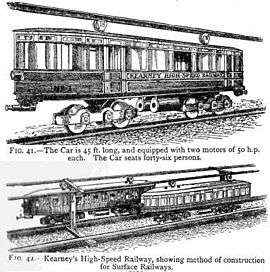Elfric Wells Chalmers Kearney
| Elfric Wells Chalmers Kearney | |
|---|---|
| Born |
February 3, 1881 Geelong, Victoria, Australia |
| Died | April 15, 1966 (aged 85) |
| Nationality | Australian |
| Other names | Chalmers Kearney |
| Occupation | Railway engineer |
| Known for | Promoter of monorail technology; author |
Elfric Wells Chalmers Kearney (February 3, 1881 – April 15, 1966) was an Australian inventor, engineer and author. Born in Geelong, Victoria in 1881, he spent most of his life in the United Kingdom. He was educated briefly at Ellesmere College, Shropshire during 1894 but left in October on account of ill health (he suffered chronic asthma & bronchitis).
His work focussed on railway engineering and he was managing director of the Kearney Railway Construction Company Ltd.
The Kearney High-Speed Tube

Kearney patented an innovative underground monorail railway system, the Kearney High-Speed Tube, which used the effects of gravity to enhance acceleration and deceleration and reduce power consumption with a "roller coaster" type of motion; from sub-surface stations, deep-level tube tunnels would fall away at a 1 in 7 gradient, enabling underground trains to reach an estimated 60 miles per hour (97 km/h) before slowing down as they climbed to the next station. The trains were unusual in that they would run on a single rail with four double-flanged wheels under each carriage; wheels mounted on the roof would run along an upper guide rail above the train. This upper guide rail, along with the carriages' low centre of gravity and the gyroscopic effect of motion, would stabilise the train on the lower rail and reduce the side-to-side hunting oscillation, thus preventing derailments and allowing greater speeds.
Kearney founded the Kearney High-Speed Tube Railway Company Ltd,[1] a venture which promoted the construction of a Kearney Tube system across London from Cricklewood and Strand to Crystal Palace. Although his proposals won support from the City of London Tradesmen's Club, they failed to win any parliamentary attention.[2]
Kearney's London scheme made no progress, but he continued to promote — unsuccessfully — the Kearney High-Speed Tube system in other schemes around the world, including New York City, Boston and Toronto.[2] In 1922 he proposed an ambitious solution to the problem of crossing Sydney Harbour by rail with a Kearney Tube.[3]
The Kearney High-Speed Tube was an untried and untested technology, and no-one was prepared to run the risk of adopting his system. None of his schemes ever made it past the drawing board and the Kearney Tube idea faded away.
Writing
Kearney was an active promoter of monorail technology, publishing leaflets and giving lectures on the subject, and wrote a book, Rapid Transit in the Future: the Kearney High-Speed Railway (1911). He later wrote a utopian science fiction novel, Erone (1943), which attempted to popularise the idea of monorail transport.[1]
Bibliography
- Kearney, Elfric Wells Chalmers (1917). The Kearney High-Speed Railway. Society of Engineers. p. 356.
- Kearney, Chalmers (1945). Erone (4 ed.). The Commodore Press. p. 253.
See also
References
- 1 2 Arnold, John; Hay, John (2008). The bibliography of Australian literature. 3. University of Queensland Press. ISBN 978-0-7022-3598-6.
- 1 2 Badsey-Ellis 2005, pp. 257-263.
- ↑ Lalor, Peter (2006). "Bradfield's Big Plans". The Bridge: The Epic Story of an Australian Icon - The Sydney Harbour Bridge. Allen & Unwin. p. 381. ISBN 978-1-74175-027-0.
- Badsey-Ellis, Antony (2005) [2005]. "Building on Success: the 1890s". London's Lost Tube Schemes. Capital Transport. ISBN 1-85414-293-3.
- Klapper, Charles Frederick (1976). London's Lost Railways. Routledge. ISBN 0-7100-8378-5.
External links
- Goods & Not So Goods - Monorails and other novel alternatives: online article contains an illustration of a Kearney railway car